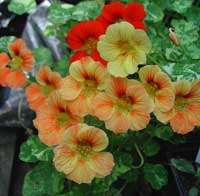Resource Library
Plant of the Week: Nasturtium (Alaska)
The University of Arkansas System Division of Agriculture does not promote, support or recommend plants featured in "Plant of the Week." Please consult your local Extension office for plants suitable for your region.
Plant of the Week
Nasturtium (Alaska)
Latin: Tropaeolum majus Nasturtium

Nasturtiums were one of the first New World plants to become popular in European flower gardens. However, they weren’t introduced as a flower but as a vegetable. The Incas used it as a salad crop and medicinal herb so the early conquistadors shipped it, the potato and the tomato back to Spain to see what the folks back home thought.
Nasturtium is a fast-growing annual that today is usually offered in its compact, non-vining form, but its true character is that of a weak-climbing vine or sprawler. It has semi-succulent, peppery tasting leaves that are round with the petiole attached in the center of the leaf blade.
Flower colors center around yellow and orange, but selections of maroon and red are available. The flowers are either single or double and about 2 inches across with a straight spur behind each. It begins blooming about eight weeks after seeds are planted and continues to bloom until hot weather arrives.
Nasturtium was brought to Spain by Nicholas Monardes, a physician who published a report in 1569 of the early epoch of Spanish colonization in South America entitled Joyful News out of the Newe Founde Worlde. In it, he describes not only plants and animals but the atrocities visited upon the Incas in an attempt to convert them to Christianity. Lima was the Spanish colonial capitol for two centuries until the South American countries won their independence in the early 19th century.
Plant naming in those early days was relatively unsophisticated, so oftentimes new plants received names related to something already known in Europe. Gerard in his early 17th century herbal considers it a kind of cress and describes it alongside the true water cress (Nasturtium officinale) which it resembles in its peppery taste. Thanks to this early classification mistake, the Latin name for a member of the cabbage family became the common name for a completely unrelated New World flower.
Linnaeus assigned the name Tropaeolum majus to nasturtium. The name is taken from the Latin word tropaeum or trophy. A yellow-flowered nasturtium twining up a post reminded the famous botanist of the practice used in ancient times of displaying shields and helmets of slain soldiers on the trunk of a tree at the scene of a battlefield.
Of the nasturtium cultivars on the market today, I like the old heirloom variety ‘Alaska’ best. In addition to the usual orange, red and yellow flowers, ‘Alaska’ has variegated foliage. The leaves are marked with irregular patches of white and cream and are attractive even when not in flower.
Amongst variegated plants it is unusual in that the variegation comes true from seed. Instead of the variegation pattern flowing from only the female line as is seen with most plants having seed-transmitted variegation, here the variegated aberration is in the DNA of the nucleus so offspring show typical Mendelian inheritance ratios.
Nasturtiums are easy plants to grow. They can be seeded in place two weeks before the expected last frost date or transplants can be grown. Plants are best in full sun or light shade in average soil. They combine well with other plants in mixed containers. Heavy feeding and too much water increases foliage growth at the expense of flowers. All parts of the plant are edible. The flowers make a colorful addition to a leafy salad.
By: Gerald Klingaman, retired
Extension Horticulturist - Ornamentals
Extension News - June 30, 2006
The University of Arkansas System Division of Agriculture does not maintain lists of retail outlets where these plants can be purchased. Please check your local nursery or other retail outlets to ask about the availability of these plants for your growing area.